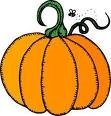
THE PUMPKIN
The name pumpkin originated from the Greek word for “large melon” which is “pepon. Pumpkins are native to North America and have been grown in America for over 5,000 years. Native Americans called pumpkins “isquotersquash.”
Pumpkins have a thick, orange or yellow shell that is creased from the stem to the bottom and contains the seeds and pulp. They are usually orange or yellow but some fruits are dark green, pale green, orange-yellow, white, red and gray. Pumpkins are a fruit! Pumpkins, like gourds and other squash are members of the Cucurbitacae family, which includes cucumbers, gherkins, and melons.
Pumpkins are monoecious, having both male and female flowers on the same plant. The small ovary at the base of the petals distinguishes the female flower. The flowers have extremely short life spans and may only open for one day.
Pumpkins are a warm-weather crop and are hardy. If many leaves and portions of the vine are removed or damaged, the plant can very quickly re-grow secondary vines to replace what was removed. The native squash bee has historically pollinated them, but this bee has declined (pesticide sensitivity) and today honeybees pollinate most commercial plantings. If there are inadequate bees for pollination, gardeners hand pollinate.
Pumpkins are grown for agricultural purposes (animal feed) and ornamental sales. Antarctica is the only continent unable to produce pumpkins. The biggest international producers of pumpkins are the United States, Mexico, India, and China. The traditional American pumpkin is the Connecticut Field variety. 1.5 billion pounds (680,000,000 kilograms) of pumpkins are produced each year in the U.S. The top pumpkin-producing states are Illinois, Indiana, Ohio, Pennsylvania, and California. According to the Illinois Department of Agriculture, 95% of the U.S. crop intended for processing is grown in Illinois. Nestlé produces 85% of the processed pumpkin in the U.S.
Farmers from all over the US compete to determine who can grow the heaviest pumpkin. Festivals are dedicated to the pumpkin and these competitions. The town of Half Moon Bay, California, holds an annual Art and Pumpkin Festival, drawing over 250,000 visitors each year and including the World Champion Pumpkin Weigh-Off. The winning pumpkin regularly tops the scale at more than 1500 pounds. In 1981 Howard Dill (of Nova Scotia) broke the record with a pumpkin near 500 pounds (226.80 kilograms). Dill patented the seeds used to grow this giant pumpkin, deeming them Dill’s Atlantic Giant seeds, and drawing growers from around the world. Dill is credited for all of the giant pumpkins today, most of which are borne from crossing and re-crossing his patented seed with other varieties. By 1994, the Giant pumpkin crossed the 1,000-pound (453.59-kilogram) mark. The current world record holder is Chris Stevens’s 1,810-pound Atlantic Giant pumpkin, which in October 2010 surpassed Christy Harp’s previous 2009 record of 1,725 pounds.
Pumpkin chucking is a competitive activity in which teams build various mechanical devices designed to throw a pumpkin as far as possible. Catapults, trebuchets, ballistas and air cannons are the most common mechanisms. Some pumpkin chuckers breed and grow special varieties of pumpkin under specialized conditions to improve the pumpkin’s chances of surviving a throw.
Native Americans dried strips of pumpkin and wove them into mats. They roasted long strips of pumpkin on the open fire and ate them. The origin of pumpkin pie occurred when the colonists sliced off the pumpkin top, removed the seeds, and filled the insides with milk, spices and honey. The pumpkin was then baked in hot ashes. Most parts of the pumpkin are edible, including the fleshy shell, the seeds, the leaves, and even the flowers. Pumpkins are very versatile in their uses for cooking. When ripe, the pumpkin can be boiled, baked, steamed, or roasted. Seeds are roasted and eaten as a snack.
